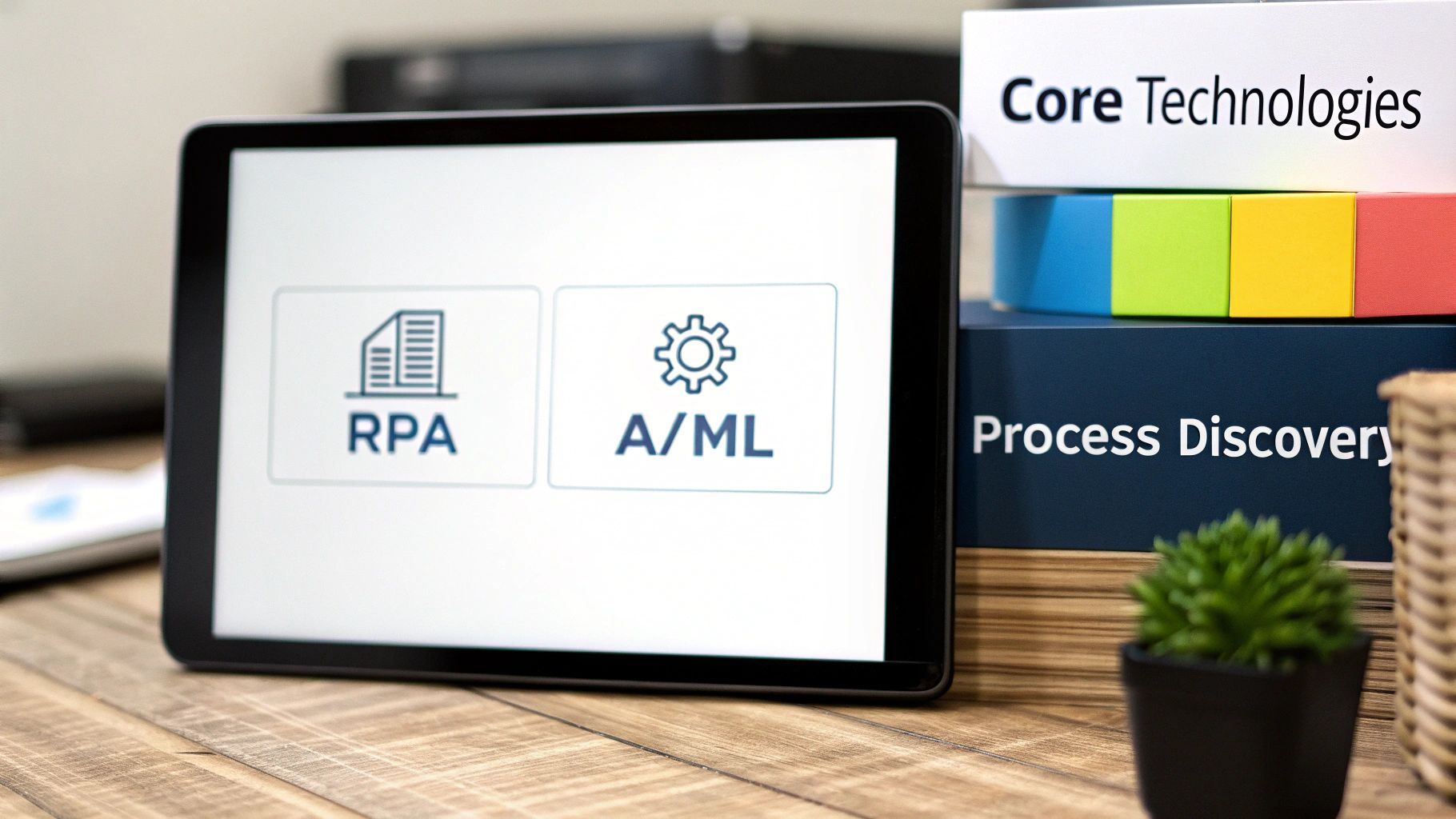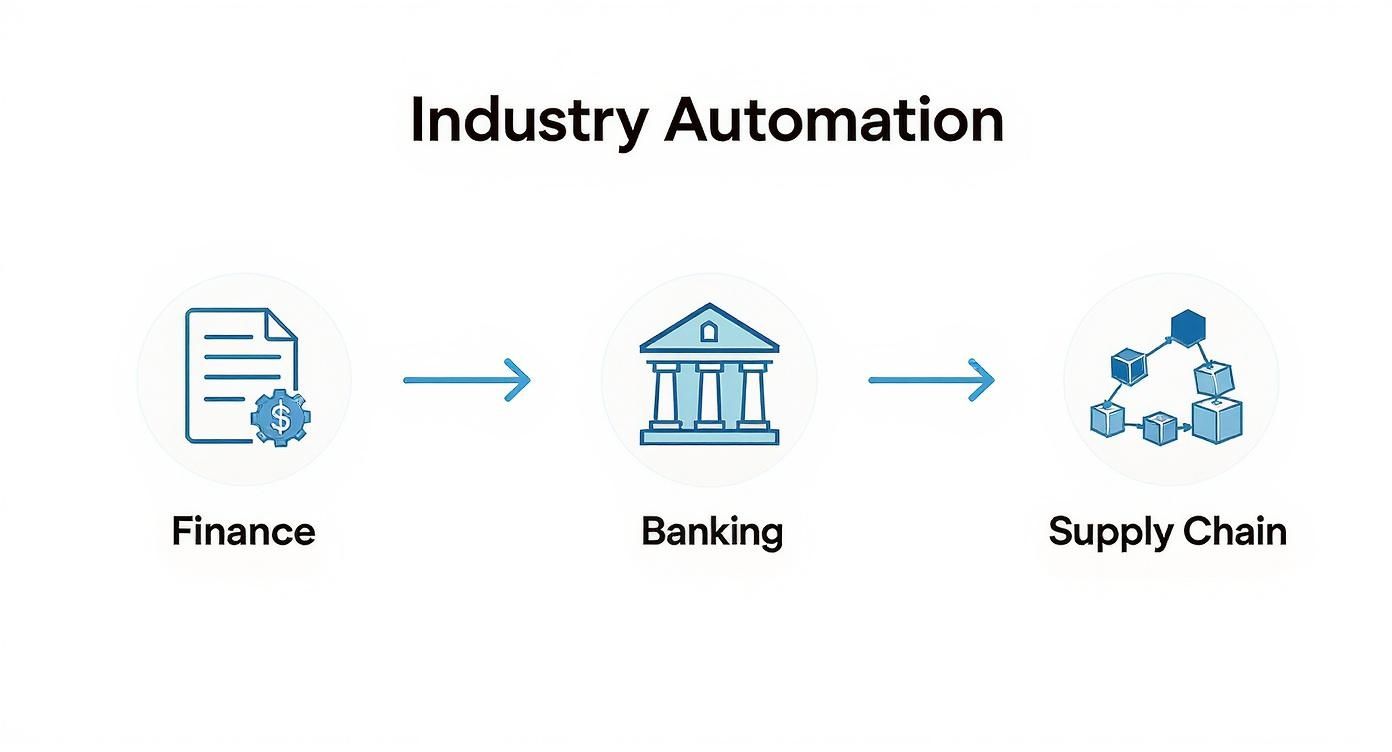What is hyperautomation? A Clear Guide to AI, RPA & More
Let's clear something up right away: hyperautomation isn't just a fancy new word for the automation you already know. It's a fundamental shift in how we think about and apply technology to business processes.
Instead of just automating one-off tasks, hyperautomation is about building an intelligent, interconnected system that can discover, analyze, and manage complex workflows from start to finish. It’s the difference between having a single power tool and having a fully automated, smart factory.
From Simple Tasks to a Smart Ecosystem

Most businesses have dipped their toes into automation. Maybe you have software that sends automatic email replies or a tool that schedules your social media posts. That’s a great start, but it’s just the tip of the iceberg.
That kind of traditional automation zeroes in on individual, repetitive, rule-based tasks. Think about automatically copying data from one spreadsheet to another. It’s linear, solves a specific problem, and then it's done. If you want to get a better handle on this foundational concept, our guide on what is workflow automation is a great resource.
Hyperautomation, however, takes a much bigger-picture view. It strategically combines multiple technologies—like AI, machine learning, and Robotic Process Automation (RPA)—to build a seamless, end-to-end automated process. We're not just trying to do one task faster; we're redesigning the entire workflow to be smarter and more adaptive.
The Orchestra Analogy
Think of your business operations like a symphony orchestra.
Simple automation is like giving one musician a player piano. It hits all the right notes for its pre-programmed song, but it can't listen or adapt to what the rest of the orchestra is doing.
Hyperautomation is the conductor. It listens to every single instrument (all your different processes and data streams), understands how they fit together, and directs them in real-time to create a beautiful, harmonious piece of music. It brings together the disciplined repetition of RPA with the smart decision-making of AI to handle truly complex and dynamic work.
This strategic power is why the market is exploding. Projections show the hyperautomation market is on track to hit $38.43 billion by 2030, a massive leap from its 2025 valuation of $15.62 billion. You can dig into the numbers in this in-depth market analysis from Mordor Intelligence.
Simple Automation Versus Hyperautomation
To really nail down the difference, it helps to see the two approaches side-by-side.
This quick comparison table shows how hyperautomation isn't just an upgrade—it's a complete evolution of the core ideas behind automation.
| Aspect | Simple Automation | Hyperautomation |
|---|---|---|
| Scope | Task-oriented; focuses on individual, repetitive actions. | Process-oriented; aims to automate end-to-end business workflows. |
| Technology | Often uses a single tool, like RPA or basic scripting. | Combines a suite of technologies (AI, ML, RPA, iBPMS). |
| Intelligence | Rule-based; follows predefined steps without learning. | Intelligent and adaptive; uses AI to make decisions and learn. |
| Goal | Increase efficiency for a specific, isolated task. | Optimize the entire business ecosystem for agility and growth. |
As you can see, we're moving from a narrow focus on task efficiency to a broad strategy aimed at transforming the entire operational fabric of a business.
The Core Technologies Driving Hyperautomation
Hyperautomation isn't a single piece of software you install. It's better to think of it as a strategic framework, a carefully assembled team of technologies working in concert. Imagine a high-performance pit crew for your business—each member has a specialized role, but they all work together with incredible speed and precision. This is what allows a business to move beyond automating simple, isolated tasks and start tackling complex, end-to-end processes.
The relentless push for operational efficiency is what’s fueling this trend. We can see this just by looking at the demand for one of its key components, Robotic Process Automation (RPA). The RPA market segment pulled in over $15.6 billion in 2024 and is on track to hit a staggering $66.5 billion by 2034. This explosive growth shows just how crucial RPA is to the broader hyperautomation picture, with cloud-based solutions now making up 53% of all deployments thanks to their scalability. You can see more data on the hyperautomation market growth from GMI Insights.

Robotic Process Automation: The Digital Hands
When people think of automation, Robotic Process Automation (RPA) is usually the first thing that comes to mind. It acts as the digital "hands" of your workforce, built to flawlessly execute high-volume, repetitive, and rule-based tasks.
Picture an employee manually copying data from an invoice, pasting it into a spreadsheet, and then entering it into an accounting system. An RPA bot can do that exact same sequence—logging into systems, opening files, copying and pasting data—but it can do it thousands of times faster without ever making a typo.
RPA is brilliant at mimicking human actions on a user interface. It’s the workhorse that handles the predictable, structured parts of a workflow, freeing up your team for more valuable, strategic work.
These bots are a lifesaver for older, legacy systems that don't have modern APIs, since they can interact with applications just like a person would. If you want to dive deeper into this foundational technology, check out our guide on what is Robotic Process Automation.
Artificial Intelligence and Machine Learning: The Brains
If RPA provides the hands, then Artificial Intelligence (AI) and Machine Learning (ML) supply the brains. This is where hyperautomation takes its biggest leap beyond simple task-doing. AI and ML introduce cognitive abilities, allowing your automated systems to handle ambiguity, make decisions, and actually learn from experience.
An RPA bot can process a perfectly structured invoice every single time. But what happens when an invoice comes in with a totally new format? That's where AI steps in.
Here's how these technologies elevate your processes:
- Intelligent Document Processing (IDP): Using Optical Character Recognition (OCR) and Natural Language Processing (NLP), this AI-driven tech can read and actually understand unstructured data from documents like PDFs, emails, and contracts.
- Predictive Analytics: ML models can sift through historical data to forecast what's coming next, like predicting customer churn or flagging potential supply chain disruptions before they happen.
- Natural Language Processing (NLP): This gives bots the ability to understand and respond to human language, which is the magic behind intelligent chatbots and tools that analyze customer feedback from thousands of emails or reviews.
By adding this layer of intelligence, you can finally automate processes that require human judgment and interpretation—things that were previously off-limits.
Process Mining and Discovery: The Eyes
You can't automate a process until you really understand it. That’s the job of process mining and discovery tools, which act as the "eyes" of your hyperautomation strategy. These tools analyze the digital footprints left behind in your company’s IT systems—things like timestamps, user IDs, and activity logs in your ERP or CRM—to create a visual map of how work actually gets done.
This gives you a brutally honest, data-driven view of your workflows. It often uncovers surprising bottlenecks, weird deviations, and hidden inefficiencies that you would never find through interviews or manual observation alone.
Process discovery tools can also actively monitor how your team interacts with applications to pinpoint repetitive tasks that are perfect candidates for automation. Together, these tools ensure you're not just automating for the sake of it; you're laser-targeting the areas where you'll get the biggest bang for your buck.
Orchestration Hubs: The Central Nervous System
With all these powerful technologies in play, you need something to manage and coordinate the entire symphony. This is the role of Intelligent Business Process Management Suites (iBPMS) and low-code/no-code platforms. They are the central nervous system of your operation, orchestrating the seamless handover of tasks between humans, RPA bots, and AI models.
An iBPMS lets you design, run, and monitor complex, long-running workflows that span multiple systems and departments. Low-code platforms, on the other hand, put the power to build directly into the hands of your business users—the people who know the processes best. They can create and roll out their own automation solutions using intuitive, drag-and-drop interfaces. This "democratization" of automation not only speeds up development but also makes sure the solutions are perfectly aligned with real-world business needs.
Here's the rewritten section, designed to sound like it was written by an experienced human expert.
What Hyperautomation Actually Does for Your Business
Let's cut through the buzzwords. What does hyperautomation really mean for your bottom line? It’s not about buying a bunch of new software; it's about making a strategic shift that delivers real, measurable results in growth, efficiency, and competitive edge. When you stop automating isolated tasks and start automating entire processes, the impact ripples across your whole organization.
We're talking about more than just speeding things up. Hyperautomation builds an intelligent, flexible system that changes the very nature of how work gets done. It’s a blueprint for a more resilient, productive, and innovative company.
Drive Serious Operational Efficiency
At its heart, hyperautomation is an efficiency machine. By connecting and automating entire workflows, you get rid of all the little things that kill productivity—the manual handoffs, the constant data re-entry, and the endless double-checking. The result is faster turnaround times and a significant drop in operational costs.
Think about a typical accounts payable workflow. Without automation, you have a team of people manually opening invoices, typing data into a system, and chasing down approvals. With hyperautomation, the whole thing runs on its own. An AI tool reads the invoice, an RPA bot plugs the data into your ERP, and an automated workflow zips it to the right person for approval based on rules you’ve already set. A process that once took days now takes minutes. This frees up your finance team to focus on actual financial strategy, not paperwork.
By weaving multiple technologies together, hyperautomation can untangle complex, multi-step processes that simpler tools just can't handle. This isn't about small, isolated wins; it's about making the entire value chain more efficient.
The financial impact is immediate and clear. We've seen businesses achieve cost savings of over 50% on migration and operational projects by taking this approach. That's a return on investment you can take to the bank.
Build Real Business Agility
In today's market, the ability to pivot quickly isn't just a nice-to-have—it's essential for survival. Hyperautomation provides the flexible, digital foundation you need to adapt on the fly. When your core processes are automated and orchestrated, you can react to supply chain hiccups, sudden market shifts, or changing customer demands without missing a beat.
Let's look at a SaaS company trying to scale its customer onboarding. A manual process will eventually hit a wall and become a major bottleneck. With hyperautomation, it looks like this:
- A new signup kicks off an automated workflow: An iBPMS takes charge of the entire customer journey from start to finish.
- AI-powered tools handle identity verification: This keeps things secure without needing a human to check documents.
- RPA bots provision new accounts: The system grants access across all necessary platforms in an instant.
- A personalized welcome email is automatically sent: Every new user gets a smooth, welcoming start.
A system like this can handle ten new customers just as easily as it can handle ten thousand. That’s what true agility is all about—being able to grow and change direction without being shackled by rigid, manual processes.
Make Life Better for Employees and Customers
Often overlooked, one of the biggest wins from hyperautomation is its effect on people—both your team and your customers. When you take the tedious, repetitive work off your employees' plates, you give them the freedom to focus on what humans do best: creative thinking, complex problem-solving, and big-picture strategy.
This does more than just boost productivity; it makes for happier, more engaged employees. Nobody enjoys spending their day on mind-numbing tasks. When people are free to contribute in more meaningful ways, you foster a culture of innovation and continuous improvement. Your team starts working with their digital assistants, not in spite of them.
And that positive internal shift directly translates to a better customer experience. When your operations are fast, accurate, and seamless, your customers feel it. They get quicker responses, see fewer errors, and enjoy more personalized service. It’s a simple feedback loop: empower your people with better tools, and they’ll create better experiences for your customers.
Real-World Hyperautomation: See It in Action
It's one thing to talk about hyperautomation in theory, but it’s another to see it solving real problems for businesses right now. This isn't some far-off concept; it's a practical strategy companies are using today to get a serious leg up on the competition. By looking at a few specific examples, you can start to see how this layered approach to automation delivers real, tangible results.
Companies are moving way beyond just automating a single task here or there. They're building smart, end-to-end systems that manage entire complex processes with little to no human input. Let's see what that actually looks like across a few key industries.
How Finance and Banking Are Being Reshaped
The financial services sector has jumped on hyperautomation in a big way. In fact, it was the largest user of this tech, making up about 28% of the hyperautomation market in 2024. North America is leading the pack, accounting for over 36% of the global market. Why the rush? It all comes down to the industry's need for ironclad security, pinpoint accuracy, and lightning speed. You can get a deeper look at the numbers in this market analysis from GM Insights.
One of the best examples is intelligent invoice processing.
Think about the old-school accounts payable dance: an invoice lands in an email, you print it out, manually key the data into your accounting software, chase down a manager for approval, and finally schedule the payment. It’s slow, tedious, and a breeding ground for human error.
A hyperautomated system turns that entire headache on its head:
- Hands-Free Intake: An AI tool watches an inbox 24/7, grabbing new invoices the second they arrive.
- Smart Data Capture: Using Intelligent Document Processing (IDP), the system reads the invoice—no matter the layout—and pulls out all the important details: vendor, invoice number, amount, etc.
- Automatic Validation: The system then checks that data against the purchase order in your ERP. If it all lines up, it automatically routes the invoice to the right person for approval based on your company's rules.
- Finalizing the Payment: Once approved, an RPA bot logs into the bank, schedules the payment, and updates your accounting records. All done.
This isn't one tool doing one thing. It's a whole crew of technologies working in concert to transform a week-long manual slog into a completely hands-off process that takes minutes.
Creating a Modern Customer Journey
Customer onboarding in banking is another area where hyperautomation is a game-changer. Nobody wants to fill out endless stacks of paper and wait days to open an account. It's a huge reason why potential customers just give up and walk away.
Hyperautomation helps create a smooth, digital experience that's both quicker and more secure.
The moment a new customer signs up online, an Intelligent Business Process Management Suite (iBPMS) kicks into gear and directs the whole show. AI tools verify their identity by scanning uploaded documents and even using biometrics. Then, RPA bots take the baton, creating the new account in all the necessary internal systems, setting up online access, and sending out a personalized welcome email.
What used to be a multi-day ordeal involving several bank employees is now a self-service experience that can be finished in less than ten minutes. The boost to customer satisfaction is massive, and it frees up your team to focus on more complex client relationships.
This high level of automation delivers a consistent, compliant, and far superior experience that builds customer loyalty from day one.
Untangling the Global Supply Chain
The supply chain is a notoriously messy web of suppliers, shippers, and warehouses. One small hiccup can cause a massive domino effect. Hyperautomation gives companies the intelligence and flexibility they need to finally get a handle on all that complexity.
Take demand forecasting. For years, it has relied on looking at past sales data and making an educated guess, which often leads to running out of popular items or having way too much cash tied up in products that aren't selling.
A hyperautomated supply chain works differently. Machine learning algorithms chew on not just historical sales data, but also external signals like weather forecasts, social media chatter, and economic news to predict what customers will want with incredible accuracy.
Here’s how it works:
- Predictive Power: The system anticipates a sudden spike in demand for a product.
- Automated Ordering: It instantly generates a purchase order and fires it off to the right supplier.
- Real-Time Tracking: RPA bots keep an eye on inventory levels across all locations, flagging problems before they happen.
- Smart Logistics: The system tracks shipments, predicts delays, and can even reroute deliveries on the fly to save time and money.
By connecting all these dots, businesses get a bird's-eye view and total control over their supply chain. It’s a proactive approach that minimizes disruptions and makes the whole operation more resilient and efficient.
To better illustrate how this applies across different fields, the table below highlights some specific use cases, the problems they solve, and the technologies that make it happen.
Hyperautomation Use Cases By Industry
| Industry | Use Case Example | Key Technologies Applied | Primary Business Benefit |
|---|---|---|---|
| Healthcare | Patient Onboarding & Records Management | IDP, RPA, AI/ML, iBPMS | Reduces administrative errors, accelerates patient intake, and ensures data accuracy and compliance. |
| Manufacturing | Predictive Maintenance | IoT Sensors, AI/ML, RPA | Prevents equipment failure by predicting maintenance needs, minimizing downtime and production losses. |
| Insurance | Automated Claims Processing | IDP, AI, RPA, Process Mining | Speeds up claim resolution from weeks to hours, reduces fraud, and improves customer satisfaction. |
| Retail & eCommerce | Personalized Customer Experience | AI/ML, Conversational AI, RPA | Analyzes customer data to offer tailored recommendations and support, boosting sales and loyalty. |
| Human Resources | Employee Onboarding & Offboarding | iBPMS, RPA, Digital Forms | Automates account creation, document management, and system access, ensuring a smooth transition for employees. |
As you can see, the applications are incredibly diverse. The common thread is using a strategic blend of technologies to solve a core business problem—whether that’s reducing manual work, delighting customers, or making operations more resilient.
Your Framework for Putting Hyperautomation into Action
Jumping into hyperautomation isn't a one-and-done project; it’s a strategic shift. You need a clear, phased approach to make sure you're automating the right things for the right reasons. Think of this framework as a roadmap, not a technical manual. It's designed to guide you from initial discovery all the way to company-wide innovation, turning ambitious goals into a real competitive edge.
Start by Discovering and Analyzing Your Processes
Before you automate a single task, you need a painfully clear, data-driven picture of how work actually gets done in your organization. This first phase is all about discovery. It’s time to move past assumptions and uncover the true state of your workflows, pinpointing the bottlenecks, inefficiencies, and mind-numbing repetitive tasks that are begging for an upgrade.
The secret here is using process mining and discovery tools. These tools act like an MRI for your business operations. They analyze the digital breadcrumbs left behind in your systems—like timestamps and activity logs in your CRM or ERP—to create a visual map of your processes. This almost always reveals surprising detours and hidden complexities you'd never spot just by watching someone work. You can get a deeper look into this crucial first step in our guide on what is process mining.
This discovery phase is your foundation. Trying to automate without a deep, data-backed understanding of your current state is like building a house without a blueprint. It’s a recipe for an inefficient, unstable mess.
By prioritizing opportunities based on their potential impact and how feasible they are, you set yourself up for a successful rollout that delivers real value right from the start.
This flow chart shows how automation can untangle core processes in areas like finance, banking, and supply chain management.

As you can see, it's about connecting a series of automated actions to transform an entire value chain, not just fixing one isolated task.
Build and Deploy with Quick Wins
Once you've identified your highest-impact opportunities, it's time to build and deploy your first automations. The golden rule here is to start small and aim for quick wins. It’s tempting to go after your biggest, most complex, company-wide process first, but resist that urge. Instead, focus on a self-contained, high-visibility workflow where you can show tangible results fast.
This could be as simple as automating invoice processing in the finance department or smoothing out the first few steps of customer onboarding. Early wins like these build critical momentum. They help you get buy-in from skeptical stakeholders and give your team invaluable hands-on experience. As you map out your first projects, using a practical guide on building AI chatbots can be a great resource for integrating intelligent components from day one.
Measure and Optimize for ROI
Getting your first automations live isn’t the finish line—it’s the starting line. The third phase is a continuous cycle of measuring, analyzing, and optimizing. You have to define clear Key Performance Indicators (KPIs) from the very beginning to track the impact of your work.
Your KPIs should be about more than just how many tasks got completed. Focus on metrics that speak directly to business value:
- Cost Reduction: How much are you actually saving in operational expenses?
- Time Savings: How many human-hours are you giving back to the team each week?
- Error Rate Reduction: By what percentage has accuracy improved?
- Cycle Time Improvement: How much faster are you completing a process from start to finish?
Review these numbers regularly to see what’s working and where you can make improvements. This data-driven feedback loop is what allows you to refine your automations, prove their ROI to the rest of the company, and pave the way for bigger things.
Scale and Innovate Across the Enterprise
With proven successes under your belt and a solid measurement system in place, you're ready for the final phase: scaling up and building a culture of innovation. This is where you move from one-off projects to an enterprise-wide automation strategy. A huge step here is establishing a Center of Excellence (CoE). A CoE is a dedicated team that sets best practices, provides training, and governs automation initiatives across the entire company.
This central team ensures that your hyperautomation efforts are consistent, compliant, and directly tied to your biggest business goals. It also helps instill an "automation-first" mindset, encouraging every department to constantly hunt for new opportunities. The global workforce in hyperautomation has already ballooned to over 700,000 professionals, with more than 63,000 new roles added in the past year alone—a clear sign of how vital these skills are becoming. With the market attracting serious investment—over 2,860 funding rounds and 910 patents—having a structured approach is the only way to stay ahead.
The Future Is Automated—Are You Ready?
Let's be clear: hyperautomation isn't just another passing tech trend. It's a fundamental shift in how modern businesses are built, run, and scaled. We've moved past automating simple, repetitive tasks. Now, we're talking about a strategic approach that uses a potent mix of AI, RPA, and process mining to intelligently orchestrate complex, end-to-end business operations. This is the new standard for what "operational excellence" actually means.
And this is just the beginning. The next leap forward is already happening, fueled by generative AI. This will make building and deploying automation easier and more powerful than ever. Imagine systems that don’t just execute the processes you design but actively suggest and create new, better ways of working on their own. We're on a clear path toward the autonomous enterprise—a business where core functions run with intelligent, self-managing systems.
Your First Step Forward
The concept of an "autonomous enterprise" can sound pretty intimidating, I get it. But you don't get there overnight. The journey starts with one smart, targeted step. Forget about a massive, "boil the ocean" overhaul right out of the gate. The most successful hyperautomation initiatives I've seen always start small and focused.
The time to act is now. Delaying adoption means falling behind competitors who are already building more agile, efficient, and resilient operations. Waiting is no longer a viable strategy.
Start by looking for a single process in your organization that's a known bottleneck—something high-friction but also high-impact. Is it the endless back-and-forth of invoice processing? The slow, manual grind of customer onboarding? Or maybe the black box of supply chain visibility? Pick one, apply the discovery frameworks we talked about, and aim for a clear, measurable win.
Taking that first strategic step does more than just solve a single problem. It builds momentum and positions your organization to lead, not just survive, in a world built on intelligent automation. The future is being written in code and algorithms, and the moves you make today will absolutely define your success tomorrow.
Got Questions About Hyperautomation? We've Got Answers
As you start to think about what hyperautomation could mean for your business, a few questions always seem to pop up. Let's tackle them head-on so you can build your automation strategy on solid ground.
What’s the Real Difference Between Automation and Hyperautomation?
The easiest way to break it down is to think about scope and smarts. Traditional automation is usually a one-trick pony—it focuses on a single, repetitive task using a single tool. A great example is an RPA bot that just copies data from one spreadsheet to another, following a strict set of rules.
Hyperautomation, on the other hand, is a whole different ballgame. It's a strategic approach that layers a full suite of technologies—like AI, machine learning, and process mining—to automate an entire, complex business process from start to finish. It’s not just about doing one thing faster; it’s about making the entire workflow more intelligent and able to adapt.
Will Hyperautomation Replace Our Employees?
This is probably the biggest concern we hear, but the goal here isn't replacement—it's elevation. Hyperautomation is built to amplify what your team can do, not make them obsolete.
Think of it this way: "Robots aren’t here to take away our jobs. They are here to give us a promotion."
– Manjunath Bhat, Research Director at Gartner
By taking over the mind-numbing, repetitive work, hyperautomation frees up your people to focus on the high-value stuff that requires creativity, critical thinking, and a human touch. Your team members stop being task-doers and become process architects and problem-solvers, working side-by-side with their new digital coworkers.
How Can a Smaller Business Get Started?
You don't need a Fortune 500 budget or a massive IT department to get in the game. For smaller businesses, the secret is to start with a focused, high-impact pilot project that can deliver a clear and quick win.
Here’s a simple game plan:
- Find a Real Pain Point: Use process discovery tools to pinpoint one specific workflow that’s a known bottleneck, is full of errors, or just eats up way too much manual effort.
- Pick a Pilot Project: Choose a process you can tackle from end to end, like accounts payable or customer onboarding. Something where you can show a measurable improvement.
- Prove the Value: A successful first project does more than just fix a problem. It builds momentum, gets stakeholders excited, and gives you a blueprint to scale your efforts across the rest of the company.
Starting small lets you learn the ropes, adapt your approach, and build confidence before you go after the bigger, more complex initiatives.
Ready to stop wasting time on manual work and start scaling your business with intelligent automation? MakeAutomation provides the expertise and hands-on support to implement AI and automation frameworks that drive real growth. Optimize your workflows and boost your ROI with MakeAutomation.






